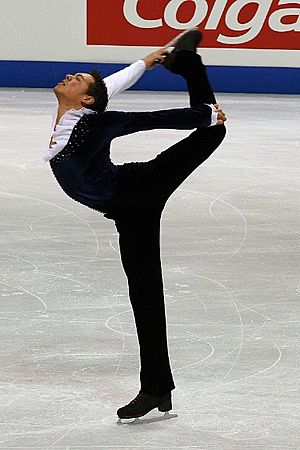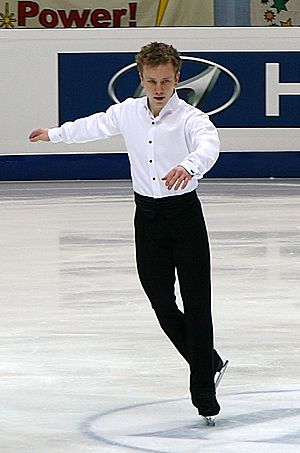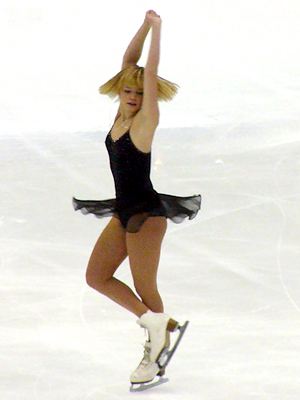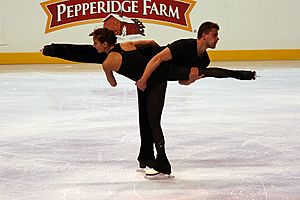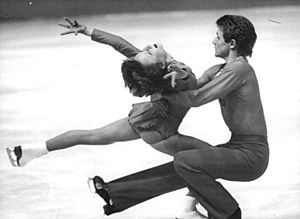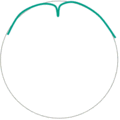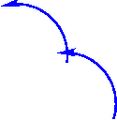Figure skating facts for kids
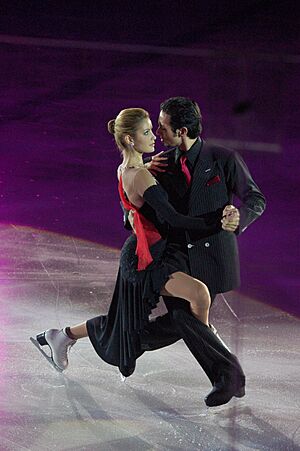
Figure skating is a cool sport and an art form where people glide on ice. They perform amazing jumps, spins, and other moves. You can see figure skating at the Winter Olympics and in its own world championships. The name "figure skating" comes from the idea of making beautiful patterns or "figures" on the ice. Skaters usually perform to music.
In figure skating, athletes can skate alone (called singles skating), or they can skate in pairs. When two people skate together, it's either pairs skating or ice dancing. In pairs skating, you'll see big jumps and sometimes the man lifting the woman high in the air. Ice dancing is different; it focuses more on intricate footwork and graceful movements, and the partners stay closer together. Another exciting type of figure skating is synchronized skating, where large groups of skaters perform together.
Contents
History of Figure Skating
The very first club for figure skating was started a long time ago in 1742, in Edinburgh, Scotland. The first World Championships for figure skating happened in 1896 in St. Petersburg, Russia. Before the Winter Olympic Games even existed, figure skating was part of the Summer Olympic Games in 1908 and 1920.
Rules of the Sport
The rules for figure skating are made by an organization called the International Skating Union (ISU). They make sure everyone competes fairly.
Singles Skating
Singles skating has two main parts: a Short Program and a Free Skate. Both parts get scores for how well the technical moves are done and how artistic the performance is.
- The Short Program (SP) is shorter and must include specific elements. These are usually two solo jumps, a combination of two jumps, three different spins, and a step sequence that uses the whole ice rink.
- The Free Skate (FS) is longer and allows for more elements. It includes various jumps, jump combinations, or sequences. Skaters also perform three spins, a step sequence, and a special choreographic sequence.
How Judges Score
Under the ISU Judging System, judges focus on two main things. They look at the quality of each move (the technical side) and the overall quality of the performance. There are usually 9 judges for each part of the competition. To get the final score for an element, the highest and lowest scores from the judges are removed, and the rest are averaged.
Technical Score
The score for each move is made up of a "Base Value" and a "Grade of Execution (GOE)." The GOE shows how well the judge thinks the skater performed the move. Judges give a GOE score from +3 (excellent) to -3 (very poor). All the scores for each move are added up to get the total Technical Score.
Presentation Score
Judges also give points for the overall presentation of the performance. They score from 0.25 to 10.00. There are five parts to the Presentation Score:
Skating Skills
- This looks at the overall quality of the skating, like how smoothly they glide.
Transitions, Linking Footwork and Movement
- This is about how skaters connect all their moves. It includes fancy footwork and how they enter and exit their technical elements.
Performance/Execution
- This measures how much the skater shows emotion and connects with the music and choreography.
Choreography/Composition
- This is about how well all the movements are arranged to fit the music and space.
Interpretation
- This shows how well the skater translates the music into movement on the ice.
Amazing Jumps
There are six main types of jumps that the ISU scores. They are listed here from hardest to easiest (based on their base score). Jumps are either "edge jumps" or "toe jumps." The Axel, Loop, and Salchow are edge jumps. The Lutz, Flip, and Toe Loop are toe jumps.
- Axel
::This is the only jump where a skater takes off while skating forward. It's usually the most difficult jump to do.
- Lutz
::The skater takes off from the back outside edge of one foot and uses the toe pick of the other skate to help push off the ice.
- Flip
::The skater takes off from the back inside edge of one foot and uses the toe pick of the other skate.
- Loop
::The skater takes off from the back outside edge of one foot. This jump is often used as the second jump in a combination.
- Salchow
::The skater takes off from the back inside edge of one foot.
- Toe Loop
::The skater takes off from the back outside edge of one foot and uses the toe pick of the other skate. This is often considered the easiest jump and is also commonly used in jump combinations.
Cool Spins
Spins are grouped into three main types: Sit spins, Upright spins, and Camel spins. Each type has many different variations. Any spin position that isn't one of the basic ones is called a "non-basic position."
Sit spin In a sit spin, the skater's upper leg (the one they are spinning on) is at least parallel to the ice, almost like they are sitting down.
- There are three main ways to do a sit spin, based on where the free leg is:
* Sit Forward (with the free leg pointing forward) * Sit Sideways (with the free leg pointing to the side) * Sit Behind (with the free leg pointing backward)
Upright spin In an upright spin, the skating leg is mostly straight or slightly bent. It's any position that isn't a camel spin.
- There are four main ways to do an upright spin, based on the skater's body position:
* Upright Forward (torso leaning forward) * Upright Straight or Sideways (torso straight up or to the side) * Upright Biellmann (a very flexible position where the free leg is pulled up high behind the head) * Upright Layback (the skater leans back, often with the free leg extended)
Camel spin In a camel spin, the skater's free leg is extended backward, and the knee is higher than the hip. However, layback and Biellmann spins are still considered upright spins, even if they look similar.
- There are three main ways to do a camel spin, based on which way the skater's belly button is facing:
* Camel Forward (belly button facing forward) * Camel Sideways (belly button facing sideways) * Camel Upward (belly button facing upward)
Turns and Steps
Skaters use many different turns and steps to connect their elements and move across the ice.
- Turns
::These include moves like three turns, twizzles, brackets, loops, counters, and rockers. Turns must be done on one foot. If a skater jumps a turn, it doesn't count as a proper turn.
- Steps
::These include toe steps, chasses, mohawks, choctaws, changes of edge, and cross rolls. Steps should also be done on one foot whenever possible.
Related pages
Images for kids
-
An example of ice dance costumes worn by Tessa Virtue and Scott Moir at the 2012 World Championships.
-
Jackson Haines is known as the father of modern figure skating.
-
Russian pair skaters Ludmila Belousova and Oleg Protopopov in 1968.
-
Takahiko Kozuka waiting for his scores with coach Nobuo Sato in the "Kiss and cry" area.
-
Denis Ten getting ready for a jump.
-
Pairs skaters Marissa Castelli and Simon Shnapir setting up for a throw jump.
-
Anabelle Langlois landing after performing a throw jump with Cody Hay.
See also
 In Spanish: Patinaje artístico sobre hielo para niños
In Spanish: Patinaje artístico sobre hielo para niños




